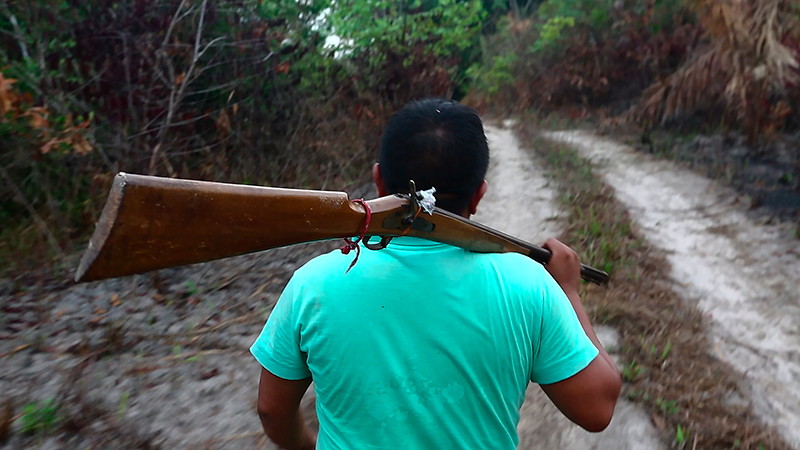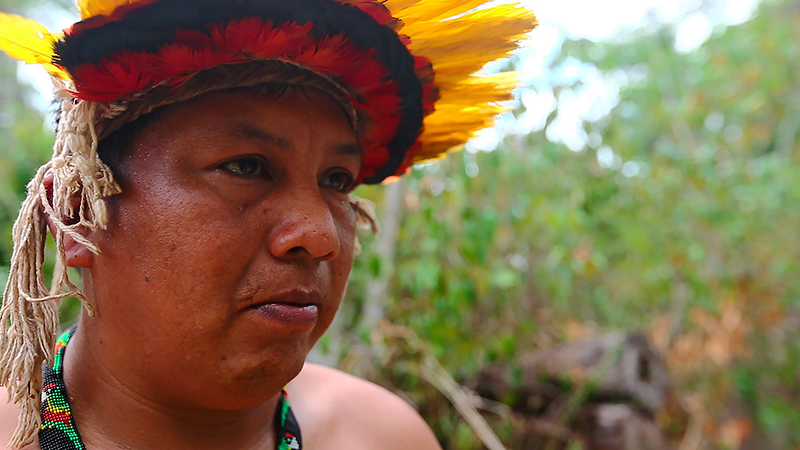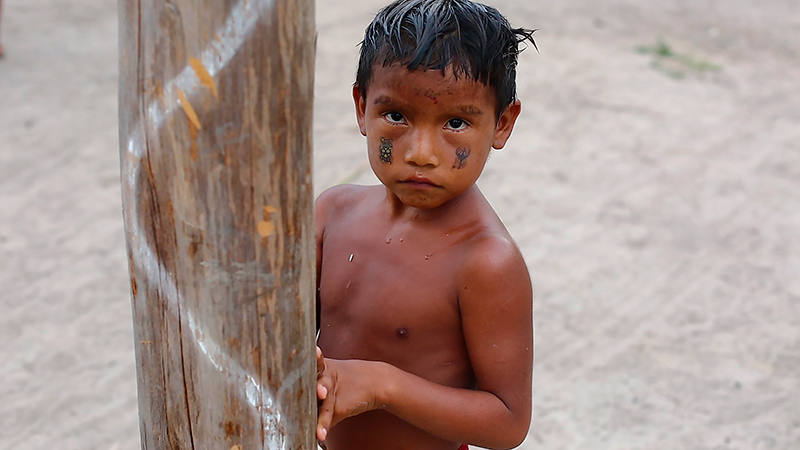PARTNER POST: Indigenous people of Maranhão seek to break with the rest of society

Piero Locatelli is from Alto Turiaçu Indigenous Land
In one of the poorest regions of the country, the Ka’apor tired of waiting for help and decided to break with the society of Karaís, as non-indigenous call it. For years they have driven loggers out of their land. They do this with their own hands and often with the use of violence. Eight years ago, they said they still asked teachers to withdraw. Now they do the same with doctors and rebuild small internal roads, ensuring that all locomotion between villages can be done within their territory. The desire for autonomy began in the Alto Turiaçu Indigenous Land, in western Maranhão, bordering Pará, due to the dissatisfaction with the treatment by different governments. After punctual operations by the Federal Police and Ibama, loggers returned to their lands, stealing hundreds of trees and setting up patios to stock the wood. Despite the presence of some professionals from the state, the natives died due to ill-made diagnoses and judged that their children learned very little from the public schools installed inside the land.
 In inspections, the Ka’apor ignites structures used by loggers. Photo: Lunaé Parracho / Reporter Brazil.
In inspections, the Ka’apor ignites structures used by loggers. Photo: Lunaé Parracho / Reporter Brazil.“Autonomy means staying alone. It is not to depend on anyone, it is to turn around,” explains Itahu Ka’apor, one of the indigenous leaders. The same term is used by other Latin American peoples who decided to change their relationship with the State since the 1990s. As governments changed on the continent, they sought to expel traffickers, loggers or other invaders from their land. In the meantime, they have also changed their form of organization and have taken back previously neglected aspects of their cultures. The state, however, still has a role to play. For the Ka’apor, the different public departments should assist them in specific aspects of areas such as education and health, but since recognizing and respecting the way indigenous people do. The idea that traditional peoples can control their institutions and way of life is provided by Convention 169 of the International Labor Organization (ILO), signed by Brazil in 2004. According to the anthropologist Spensy Pimentel, a professor at the Federal University of South Bahia, the organization of groups such as Ka’apor does not mean an affront to the State, but rather a legal practice that must be protected.
This change of the Ka’apor began well before the inspection of the territory. The actions in which they expelled the loggers from their land made the Ka’apor gain international attention, but they are the consequence of a deeper process of change. It all started about eight years ago, when they decided to break with the educational system imported from outside the villages. For them, the expulsion of teachers from outside the Indigenous Land was the first step.
Education: the beginning of autonomy
The most striking distinction between the Ka’apor and the people living around their land is the language. Children inside the land do not even respond to calls in Portuguese, and among the elders the conversations stretch for hours in the Ka’apor language, spoken only by the 1,900 indigenous people. Language was the basis of a new education system. Since then, children only learn Portuguese after they turn 11. Until that age, all classes are in the indigenous language. The division into series is also not followed in the same way by schools outside the village, since children are mixed in groups with different ages. They also emphasize that their education is much more practical than that outside the village. “If I just study, I’ll forget what I learn,” explains Itahu.
 Ka`apor children are literate in Portuguese only when they are 11 years old. Photo: Lunaé Parracho / Reporter Brazil.
Ka`apor children are literate in Portuguese only when they are 11 years old. Photo: Lunaé Parracho / Reporter Brazil.From the government, the Ka’apor still require the structure for classrooms and snacking. In addition, they seek the formal recognition of Ka`apor teaching outside the village. The assistant secretary of state education, Nádia Dutra, acknowledges that the situation is precarious due to a “historical neglect” of the state in the area. She states that the current government has advanced in the discussion with different indigenous communities, including the Ka’apor. Dutra says that the government of Maranhão recognizes the demands and peculiarities of these natives, and that now it waits for the Ka’apor to send a pedagogical plan, so that the particularities of its system can be recognized. The creation of a Ka’apor education system made villages create greater links between them. With the dialogue established through education, indigenous people say they have created the conditions to completely change the way they organize themselves.
The end of the cacique
The process of resuming education led to the realization that their former leaders, the caciques, were not a traditional Ka’apor institution, but would have been imposed by Funai in previous decades to mediate the agency’s relationship with the villages. “The cacique never solved the problems of the community. He had alcoholism inside the villages, gossip, fights. But the chief could not deal with it, “says Iratowi. When realizing this, they took the most important attitude in search of autonomy: they finished with the cacique. The villages were united around a council of seven leaders, who today make decisions collectively. Today, 14 of the 17 villages respond to the “council of tuxás”, name given to these leaders.
 Indigenous representatives of the Ka’apor ranger, established in 2013 to expel the loggers. Photo: Lunaé Parracho / Reporter Brazil.
Indigenous representatives of the Ka’apor ranger, established in 2013 to expel the loggers. Photo: Lunaé Parracho / Reporter Brazil.In the council, decisions are made collectively, in contrast to the caciques who made decisions unilaterally. In addition to the group formed by the tuxás, each village also has its own council, where local decisions are taken and punishments for those who fail to agree. Soon in its creation, the council prohibited the consumption of alcoholic beverages inside the Indigenous Land, origin of health problems and currency to “buy” the entrance in the earth. Along with the ban on alcohol, they started an even more difficult constraint – that of loggers inside the land. With indigenous people from different villages, in 2013 the Ka’apor ranger was created.
Forest protection
In the void of the state, the indigenous control actions of the land are the most controversial, since they tend to be violent. The images recorded and released by the Ka’apor reveal groups of lumbermen sitting on the ground with their hands tied behind their backs as they hear the indignation of Indigenous carrying lead shotguns and bows. In a video of 2014, you can see that one of the loggers has a purple neck, a knock signal he had just taken. From one finger to the other, one of the Ka’apor explains why they were in that situation, in a speech that mixes aggression and kindness: “Please, do not enter here any more. We do not touch your things there.” This type of situation has become routine for the Ka’apor guard, who has carried out several similar actions since 2013, until he can reduce the number of invaders. Despite fulfilling the expected function, the Indigenous attacked the weakest part of the long chain of deforestation: loggers hired to do the cutting work, the heaviest and least valued in the industry. Several times, loggers’ bridges and trucks were burned so they would not return to the site. In some of these cases, the loggers had to return to the city on foot. “If it does not burn, the other day the logger steals with the same truck,” explains Iratowí Ka`apor. On the other hand, indigenous people are also victims of violence. Actions to protect the territory generate ever greater reprisals. The worst moment of conflict occurred in 2015. After receiving a series of threats, the indigenous Euzébio Ka’apor was killed in an ambush with a shot in the back near the village where he lived and where some of the surveillance actions were going. (See video and read report made at the time of the murder) For the Ka’apor, there is no doubt that death is related to their protective actions. The Federal Police, however, have not yet reached a conclusion on the case. The delegate who coordinates the investigation, Francisco Roberio Lima Chaves, did not respond to Reporter Brazil’s requests for an interview . In the midst of conflicts, the guard is internationally recognized. In 2016, it was highlighted by the United Nations Special Rapporteur on the Rights of Indigenous Peoples, Victoria Tauli-Corpuz, as an example of “proactive approaches by indigenous peoples” to the realization of their rights. International organizations such as Greenpeace and Global Witness also supported the initiative. The Brazilian State, however, did not view its creation in the same way. At the time the case became known in Brazil, then Justice Minister José Eduardo Cardozo called for an investigation into the actions of the indigenous people. The current Funai administration has informed that “it does not support and nor can it support inspection actions carried out by indigenous people”. According to the foundation, only state agencies with police power can do this activity. Funai reported that in 2017 it used “around 1 million reais in protection measures for priority areas, which includes Alto Turiaçu Indigenous Land.
 Itahu Ka’apor is part of the council of the Ka’apor, created after they abolish the cacique. Photo: Lunaé Parracho / Reporter Brazil.
Itahu Ka’apor is part of the council of the Ka’apor, created after they abolish the cacique. Photo: Lunaé Parracho / Reporter Brazil.Despite being the best-known face of the Ka’apor’s territorial defense, guarding is not the only way for indigenous people to prevent the destruction of their forest. To curb the entry of loggers, the Indigenous began to establish “protection areas”, which are small villages at the end of roads improvised to remove timber from the territory. Today, there are seven protection areas established in clearings where there were only stacks of logs until a few years ago. According to the indigenous, the strategy has worked. “When the Federal Police left, the next day the logger came in again. Now it’s different, and that has calmed down for us, “says Iratowí Ka’apor, one of the leaders. The data corroborate the perception of the Indigenous. Alto Turiaçu, where they live, has had only 0.4% of its deforested territory in the last four years, according to data compiled by Global Forest Watch from Prodes, a federal government project that monitors deforestation. In the same period, a neighboring territory, the Awa Indigenous Land, lost almost 2% of the forest cover in the same period – that is, a destruction five times greater. Thus, the Ka’apor have protected most of what is left of the Amazon rainforest in Maranhão According to data from the National Institute of Space Research (INPE), little more than half of what is left of the forest in the state is inside Indigenous Lands , and the most preserved of them is Alto Turiaçu. This is easily seen in satellite photos, which show the contrast of the preserved area with the surroundings. Looking at the map, the Ka’apor land border is easily located, marking exactly where the vegetation cover begins.
With the territory under control – and under constant surveillance – the Ka’apor now prioritize two other changes: direct health care and create strategies to isolate themselves from nearby cities.
Cheers
At the end of the last year, a series of imprecise diagnoses led to the death of the indigenous Sokohi Ka’apor, who had just had a child. At the indigenous service station in the nearest town, Zé Doca, she was informed that she had only a urinary tract infection and that she should return to the village where she lived. Days later, he died of undiagnosed pneumonia. Before the death, the Indigenous already warned that they were neglected by the Special Secretariat of Indigenous Health (Sesai). But the case was the trigger for them also to seek the break with the “karaís” in health. Now, says Itahu, they want to have control over local health care and that doctors and nurses respect traditional Ka’apor medicine. “I do not need the Karai medicine. I have mine, well kept in nature. If you have a cold, I have honey in the bush, I have grass in the bush, “says Itahu.
 Itahu Ka’apor in a place taken over by the indigenous, where it used to be a logging yard. Photo: Lunaé Parracho / Reporter Brazil.
Itahu Ka’apor in a place taken over by the indigenous, where it used to be a logging yard. Photo: Lunaé Parracho / Reporter Brazil.The Ka’apor try to reconcile the two practices, sought help from volunteers. “Today we are asking for a van, a doctor and a nurse. If they guarantee it to us, it’s perfect. No one will ask for more from the government, “says the leadership. The Ministry of Health said that indigenous people receive care from two health teams, composed of about 12 professionals, and that “there is no record of prejudice or maltreatment by health professionals with this population.” The ministry, however, confirmed that it has not done medical care in the Xiborendá village, the largest of the Alto Turiaçu Indigenous Land where more than five hundred indigenous people live. According to the ministry, this happens “for non-acceptance of the indigenous people themselves.”
Off the map
Going from one village to another in the Indigenous Land can be a long and dangerous process. It is necessary to walk more than forty kilometers by settlements on poor roads with little or no illumination, and to make a route by the asphalt, where it goes through the cities where many residents are hostile to the natives. Searching for shorter and less dangerous paths, the Ka’apor now build small roads within the land itself. A journey between two villages, which now takes five and a half hours, can be done in thirty minutes. Being able to walk or drive a motorcycle from one village to another, without even passing through the world of Karaís, symbolizes an important part of the autonomy so desired. To better explain the persistence in his quest to “stay alone,” Itahu finds his greatest reference in the forest: the jabuti. “The Ka’apor people do not have to go back to the government, a crap that brings nothing to us. And jabuti lives alone, has no friend. We have to copy it. ” Itahu does not yet know how much time and effort will be required to complete the process of autonomy, but says that it should persist as long as necessary. For this, it remembers another characteristic of the jabuti. By tying the tail of the animal, Itahu says, he will continue to walk forward, intending to the utmost what binds him. “He may try more than a month, but he will break the rope.”
 Photo: Lunaé Parracho / Reporter Brazil.
Photo: Lunaé Parracho / Reporter Brazil.

